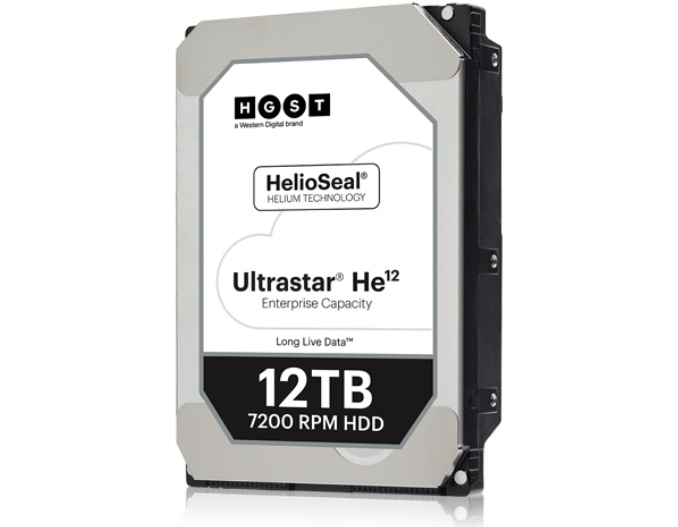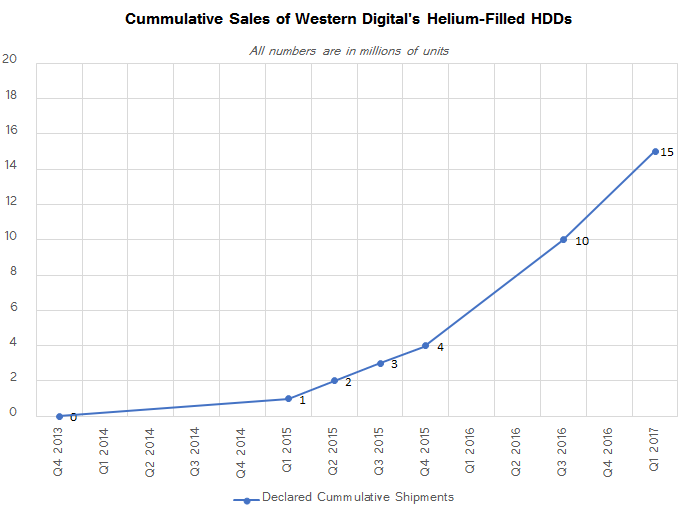Western Digital: Sales of Helium-Filled HDDs Accelerating, 15M Sold So Far
by Anton Shilov on May 13, 2017 3:00 PM EST- Posted in
- HDDs
- Storage
- Western Digital
- HGST
- SMR
- Helium HDD
- Ultrastar
- HelioSeal

Western Digital recently announced that it had sold 15 million helium-filled hard drives, indicating that sales of such HDDs are accelerating. Since the launch of the HGST HelioSeal platform about 3.5 years ago, it has enabled HGST to make a number of technological improvements to its hard drives in terms of their capacities. It is noteworthy that while Western Digital is expanding usage of helium, it has not announced plans to expand usage of shingled-magnetic recording (SMR).
HGST, a subsidiary of Western Digital, started volume shipments of its first-generation helium-filled Ultrastar He-series hard drives in November 2013. HGST sold about a million HelioSeal HDDs in the first 1.5 years on the market, but once numerous operators of large cloud datacenters qualified such drives, their sales started to accelerate. For example, HGST supplied 1.1 million of helium-filled HDDs in Q3 2015 — more than in their first six quarters on the market. Meanwhile back in October of last year, Western Digital said it had sold 10 million HelioSeal hard drives. As it appears from the recent comments made by the company, in just a couple of quarters it has managed to sell another five million helium HDDs with cumulative shipments of such drives topping 15 million units since late 2013.
“I am pleased to note that we have now shipped approximately 15 million helium hard drives cumulatively since the platform's launch four years ago,” said Michael D. Cordano, president of Western Digital, during a conference call with investors and analysts.
There are multiple reasons why sales of HelioSeal-based HDDs are accelerating. First, the demand for datacenter hard drives is growing, and operators have finally qualified helium-filled HDDs for new deployments. Second, with the systematic increase of drive capacities (a new capacity point is launched every 12 – 18 months), Western Digital can gradually increase shipments of helium-filled drives to existing and new deployments. Third, Western Digital is expanding usage of helium beyond datacenter-class drives to NAS and even consumer HDDs.
From technology standpoint, HelioSeal has made quite a bit of progress in the recent 3.5 years. Initially, it enabled HGST to place seven platters into a single 3.5” HDD and offer a 6 TB drive, which in turn had lower power consumption and higher performance than various competitors. Installation of seven platters into one drive required HGST to redesign some of the internal HDD components, and this is always a challenge. Moreover, late last year HGST introduced an even denser hard drive, the Ultrastar He12 with eight platters, which again required the company to redevelop internal architecture of the HDD.
When it comes to practical progress, the helium-filled Ultrastar drives doubled their capacity from 6 TB in Q4 2013 to 12 TB in Q1 2017. By contrast, conventional air-filled PMR-based drives have not yet made it past 8 TB, increasing their capacity by 33% from 6 TB in Q1 2014. Meanwhile, if we take the SMR-based Ultrastar He12 with 14 TB capacity into account, then the progress will seem quite impressive as well (a 75% increase from 8 TB in August 2013 to 14 TB in 2H 2017).
Speaking of SMR, it does not look like Western Digital is eager to share its plans regarding usage of the technology.
“Shingle [magnetic recording] has been a little bit more limited in terms of the applications because of some of the performance implications of that and that sort of thing,” said Stephen Milligan, CEO of Western Digital. “We feel comfortable with where we are at in terms of SMR transition and the applicability and the drives that we are providing to our customers.”
Unlike drive-managed SMR HDDs from Seagate, SMR HDDs from Western Digital should be managed by hosts and are therefore used only for active archive/deep-archive applications that can support it. This reduces their addressable market, but the company still sells plenty of them: 20 – 35% of data stored today belongs to the two aforementioned categories. Meanwhile, Seagate offers drive-managed SMR-based HDDs for both consumers and datacenters, something that Western Digital does not. For the time being at least, it looks like the company is not planning on disclosing any kind of roadmap for drive-managed SMR devices.
Related Reading:
- Western Digital Starts Shipments of HGST Ultrastar He12 12 TB HDDs
- Western Digital Introduces Its First Helium-Filled HDDs for Consumer Applications
- Western Digital Expands Purple Lineup with a 10 TB Helium-Filled HDD
- Seagate Announces Enterprise Capacity 12 TB HDD: 2nd-Gen Helium-Filled Hard Drives
- Western Digital Adds Helium-Filled WD Gold 10 TB HDD to Lineup
- Seagate Ships 35th Millionth SMR HDD, Confirms HAMR-Based Drives in Late 2018
- Seagate Confirms Plans for 12 TB HDD in Near Future, 16 TB HDD Due in 2018
Source: Western Digital











29 Comments
View All Comments
dgingeri - Sunday, May 14, 2017 - link
I have had similar issues with Seagate drives, with nearly every drive I've had from them fail over the years, yet despite having over 30 WD drives over the last 27 years, I have only had one WD drive fail on me. I've also had about 20 Hitachi drives, including 6 4TB drives I'm running right now, and not a single failure from them.For 6 years, I was a sysadmin for a test lab for server level storage products. I had a LOT of drives to caretake during that time. In that time, Seagate were, by FAR, the least reliable drive I dealt with, and Toshiba pretty close behind. (I had one model of Toshiba, a 15k rpm 146GB 2.5" SAS drive, that had every single drive fail over the course of 3 years. We had 13 in every Dell R910 we had, with 21 more in a MD1220 attachment with a third of the R910s having 2 MD1220s. So, in short, we had several hundred of these drives. In three cases, when the drive failed, it failed so spectacularly that it damaged the backplane of the R910.) WD was third, but pretty far behind Seagate and Toshiba. Hitachi was by FAR, the best of the lot, with about a dozen failures out of a sample size of about 2000 1TB SATA drives.
After my experiences in that test lab, I will not buy any other brand internal drive other than HGST. Since HGST doesn't have USB drives that I've found, I do go with WD for my external backup drives.
One other thing I've learned from storage, never back up to another internal drive. Always backup to an external drive. You never know when a power supply issue will kill all the drives in your system. At that point, your backups don't mean squat.
Magichands8 - Saturday, May 13, 2017 - link
Great! All this means they can start reducing prices, right? Implementing these new technologies to increase capacity is nice but it's increased drive costs substantially. In all the time since these have been on the market I haven't seen prices drop below about $0.35/GB.harobikes333 - Saturday, May 13, 2017 - link
Magichands... unless the market puts pressure on the prices, why would they cut their profits??cbm80 - Saturday, May 13, 2017 - link
Cramming more platters doesn't reduce costs. Neither does helium. The only benefit is that data centers can save some space and power.Xajel - Sunday, May 14, 2017 - link
HeF-HDD is still a new technology, and new technology comes with a price. in addition to that, it's really not necessary in low capacity HDD's, as these can work already without it so adding it means adding costs for nothing.In another hand HeF-HDD is only meant to give the ability to add more platters, denser platters while maintaining the RPM speed without worrying about heat, vibration, stability and other factors which comes with such methods of increasing density without using denser platters which take longer time.
So when 8TB and larger HDD's becomes mainstream, then you might see HeF-HDD's becomes feasible in consumer market.
HAMR is also coming, but again it's very difficult to make, that's why we don't have it yet ( coming next year IIRC ), this technology will increase the density also and it can work with or without HeF-HDD, but it's cost in the first place will make it expensive so as usual we will see it first in high-margin market ( enterprise/datacenters ), later it will make it's way toward consumers.
StrangerGuy - Sunday, May 14, 2017 - link
Apple already proved maximizing margins/unit sold in a sufficient enough volume is a much more profitable approach than the old days of winning raw marketshare or volume sold. That means the consumer market are getting the shaft in favor for big iron enterprises who as much less price sensitive. Case in point: Ryzen is slaughtering Intel in consumer desktop CPU market yet Intel didn't even bother fighting AMD in a price war, but instead raised prices with Skylake-X. Same goes for NV aiming HPC first and gaming a distant second.Beaver M. - Sunday, May 14, 2017 - link
Skylake-X isnt released yet and the prices arent known yet either...iwod - Sunday, May 14, 2017 - link
So in the last 12 months, they shipped 10 million of these HDD, if we assume 10TB per unit sold, that is 100 Million TB, or 100 Exabytes!!!!At the end of 2013 Facebook reported a 300PB of Storage, even if it had grown 10x in 4 years, that is still only 3EB!. Facebook users nearly double from 2013 to 2017, even if you another 3.3x multiple that is still only 10EB!
ZeDestructor - Sunday, May 14, 2017 - link
The newest number I can find is from 2015, when YouTube claimed 400 hours of video uploaded per minute. Assuming that it's increased another 100 hours per minute since then (it's been linear since they hit 100 hours per minute), that's 500 hours per minute. Some Wolfram|Alpha later, that works out to 60gbit/s = 648TB/day = 236.5PB/yr.All that gotta get stored somewhere, in multiple resolutions, in multiple copies. And then you have nutters like me upload at proper bitrates and allow youtube to stream to you in so-called "original" quality, so probably around the 1EB/yr. And that's just one service.
Once you have all the other stuff.. AWS, S3, Google storage, GCE, etc... 100EB/year doesn't look that far-fetched when you're talking about what is literally half of the HDD industry's high-capacity production, does it?
Dug - Monday, May 15, 2017 - link
Users are sucking the helium out of the drives, so they aren't actually being used for storage.